This post contains affiliate links.
Art memory games are a no-brainer to generate interest from small children for art. They love matching tiles and they win against adults! But how many such games are out there and are they all so basic? I wanted to find out.
There are currently 20 published art history memory games: 12 basic ones that can be used with young children to introduce them to fine art without actively teaching, and 8 advanced ones that include active learning within the rule by proposing cards that match if you analyze their content.
You might think that memory games are boring, but read on! Not only are art-based memory games great because they introduce young children to art, but also some of them are really imaginative and manage to introduce art styles or specific techniques such as sketches, collage, optical illusions or photo editing.
Memory Games With Multiple Artists
6 Memory Games about Old Art Masters (Up to 18th Century)
Old Masters Memory Game (BisPublishers)
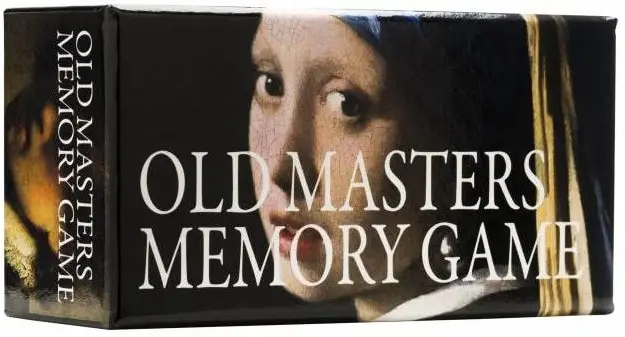
Old Masters Memory Game (by Mieke Gerrizen) features 50 famous portrait paintings (the paintings are cropped to show generally only the faces of the portrayed people) by different painters from the 16th and 17th centuries (Rembrandt, Vermeer, da Vinci, Botticelli, Titian, Hals, Durer, Goya, and many others).
(by Mieke Gerrizen) features 50 famous portrait paintings (the paintings are cropped to show generally only the faces of the portrayed people) by different painters from the 16th and 17th centuries (Rembrandt, Vermeer, da Vinci, Botticelli, Titian, Hals, Durer, Goya, and many others).
The rule is to collect two portrait paintings by the same painter (the paired memory cards are not identical). The sets are recognizable by the style of painting, the people who were portrayed, their attitude and style.

Pairing is sometimes very easy, like with these two paired cards where the characters, the style, and the attitudes are similar.

It can be a bit more difficult when the attitudes of the subjects are not exactly the same.

Or it can be even more challenging when only the style of the painter gives you the answer.
Each painting is not identified by name anywhere, but there is a brochure with all the paintings in pairs and a little explanation on the painters which enables to check the pairing of cards if the players are not sure.
The cards are of good quality. They are square-shaped with a size of about 2.7 inches (7 cm).
I like this game very much because it teaches the children to recognize some essential traits of the style and the subjects of each painter. And where there is a doubt, it is always a great opportunity to have a discussion with the child (or between children) about why the two paintings should be or should not be from the same artist.
So this is the reason why I highly recommend this game which goes a step further than the average art memory game.
Art Memory Game (Art Institute Chicago)

The art memory game from the Art Institute of Chicago is a simple (24 pairs of identical artworks) card memory game featuring works from their permanent collection (a very rich one).
is a simple (24 pairs of identical artworks) card memory game featuring works from their permanent collection (a very rich one).
The cards are square-shaped with a size of 3″ (7.6 cm).
I like that there is a text under each artwork that enables going beyond the matching game and starts discussions with the children.
Art Smart Game (Art Institute Chicago)
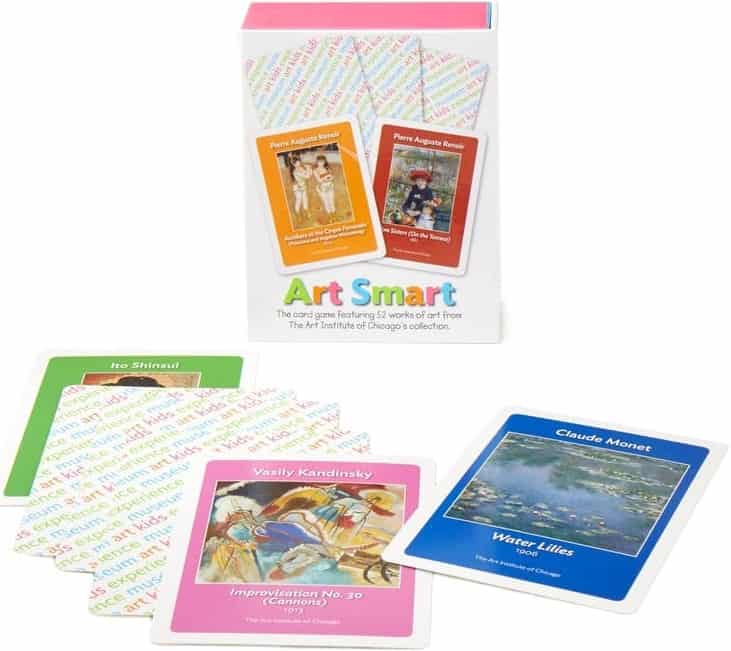
The “Art Smart Game” from the Art Institute of Chicago is different from the “Art memory Game” because of its card matching mechanism. Instead of matching pairs of identical cards, you match cards from the same artist or the same culture (just like with the “Old Masters Memory Game” by Bispublishers).
The game comprises 52 cards (26 pairs) of 3 3/4 x 2 1/2 inches (8.7×6.3 cm) – a size similar though a bit wider to standard playing cards.
Baroque Art Epochs Memo (Ullmann)

In Memo Game Baroque , 24 artistic works are each depicted on two cards (square cards about 2.7 inches wide). The rules are the standard ones with memory games.
, 24 artistic works are each depicted on two cards (square cards about 2.7 inches wide). The rules are the standard ones with memory games.
The selection of the cards provides a cross-section of the baroque period’s art and architecture, especially in Germany and Austria.
The game comes with a booklet that describes each of the 24 artworks and gives an overview of Baroque Art and architecture.
Gothique Art Epochs Memo (Ullmann)

In Memo Game Gothic , 24 artistic works of the gothic period are each depicted on two cards (square cards about 2.7 inches wide). the rule of the game is the standard memory one.
, 24 artistic works of the gothic period are each depicted on two cards (square cards about 2.7 inches wide). the rule of the game is the standard memory one.
The game includes a booklet that describes each picture and gives an overview of Gothic art and architecture.
Hermitage Masterpieces Memory Game

The Hermitage is among the largest museums in the world (comparable to the Louvre in Paris for instance) and has one of the largest art collections in the world. Hermitage Memory is a game based on this wide collection of paintings.
is a game based on this wide collection of paintings.
The rules are the standard rules of memory (twin cards are identical). There are 72 square cards (36 masterpieces), with a size of 2.6 inches (6.6 cm). So the cards are rather small but the artworks are printed on the full surface of the cards (and thus cropped).
6 Memory Games about 19th, 20th, and 21st Century Art
Impressionist Art Memory Game (Piatnik)

This Impressionist Art memory Game is not printed anymore, but you can still find it on Amazon or Ebay (used). The game comprises 72 cards (36 pairs) of Impressionist Art pieces by Van Gogh, Monet and more! The square cards are about 2.6 inches wide. The printing is beautiful, as can be expected from Piatnik.
is not printed anymore, but you can still find it on Amazon or Ebay (used). The game comprises 72 cards (36 pairs) of Impressionist Art pieces by Van Gogh, Monet and more! The square cards are about 2.6 inches wide. The printing is beautiful, as can be expected from Piatnik.
Modern Art Memory Game (AMMO)

The “Modern Art Memory Game ” has 72 cards, featuring 36 paintings (twice each as it is a memory game) from 36 famous artists like Warhol, Munch, Matisse, Picasso, van Gogh, Kandinsky and more.
” has 72 cards, featuring 36 paintings (twice each as it is a memory game) from 36 famous artists like Warhol, Munch, Matisse, Picasso, van Gogh, Kandinsky and more.
There is also a booklet with the name of the artist, the piece, and the year it was created. As the game of memory is for really small children, another rule is proposed based on earning points for remembering facts behind each artwork.
I recommend this memory game for families with small children (Kindergarten or preschool) as it is not too expensive and the quality of the cards is good (but the cardboard used for the cards is not so solid).
But there is a real missed opportunity to make a game that could also be interesting from a teacher’s point of view by beefing up the information in the booklet concerning each painting. It would have been so much better to have more facts there to make the second rule more worthwhile.
Another disappointing thing is that the works of art are not numbered, making them more difficult to find in the booklet.
Street Art Memory Game (Bispublishers)

In Street Art Memory Game (Janne Ettwig and Lilian van Dongen Torman), you have to match two works by the same street artist. It features 30 of the most influential street artists of our time, such as Banksy, Invader, David De La Mano, ROA, e1000ink, Evol, JR, Mobstr, MTO, Shepard Fairey, Stik, Varini and Vhils.
(Janne Ettwig and Lilian van Dongen Torman), you have to match two works by the same street artist. It features 30 of the most influential street artists of our time, such as Banksy, Invader, David De La Mano, ROA, e1000ink, Evol, JR, Mobstr, MTO, Shepard Fairey, Stik, Varini and Vhils.
The square cards are about 7 cm wide (2. inches).
So this is more difficult than a standard memory game, where the two cards to match are identical. Here they are from the same artist so that you have to analyze the styles to match the artworks, which is, in my opinion, an excellent way to introduce the different styles of the artists to students.
Memo Street Art (Ullmann)

In “memo street art” by Johannes Stahl, 24 artworks are each depicted on two cards. So the rule of the game is the standard memory.
Street art is a controversial art form but is “available” in the street to those of us who live in large cities where this type of art takes place.
Note that the game is in German!
Ditto American Art (Birdcage Press)
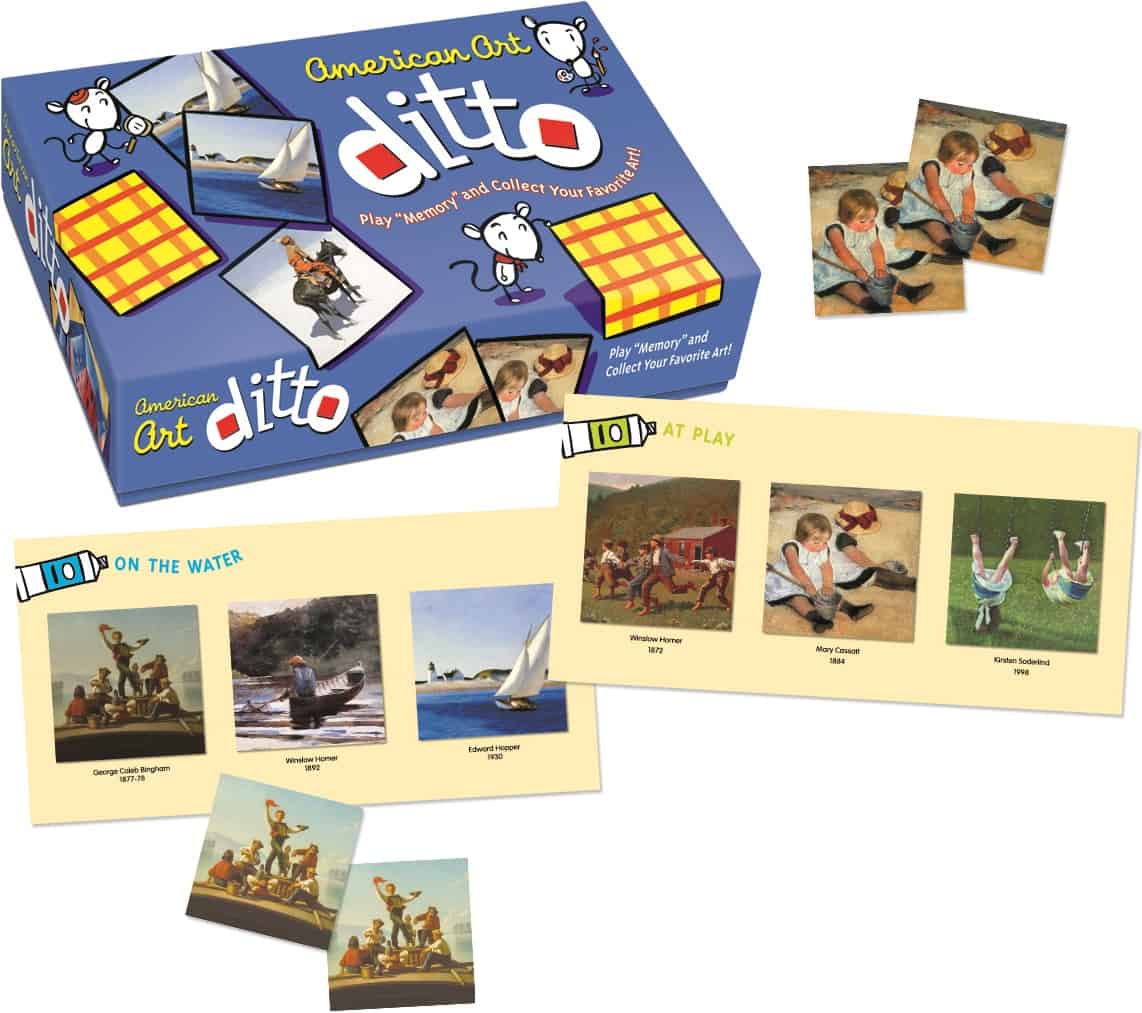
Ditto American Art is a classic memory game, just like Modern Art Memory Game by AMMO. It has 48 art tiles (24 works of art) and 8 large cards to recall the different card families. The fact that there are also families enables playing other rules such as Happy Family.
is a classic memory game, just like Modern Art Memory Game by AMMO. It has 48 art tiles (24 works of art) and 8 large cards to recall the different card families. The fact that there are also families enables playing other rules such as Happy Family.
So this game is nice for Preschool or Kindergarten (3 to 5 year-olds), but also for younger elementary students thanks to the possibility of family games; it is also the only game listed here that focuses on American Art.
AGSA memory game (Australian Gallery of South Australia)
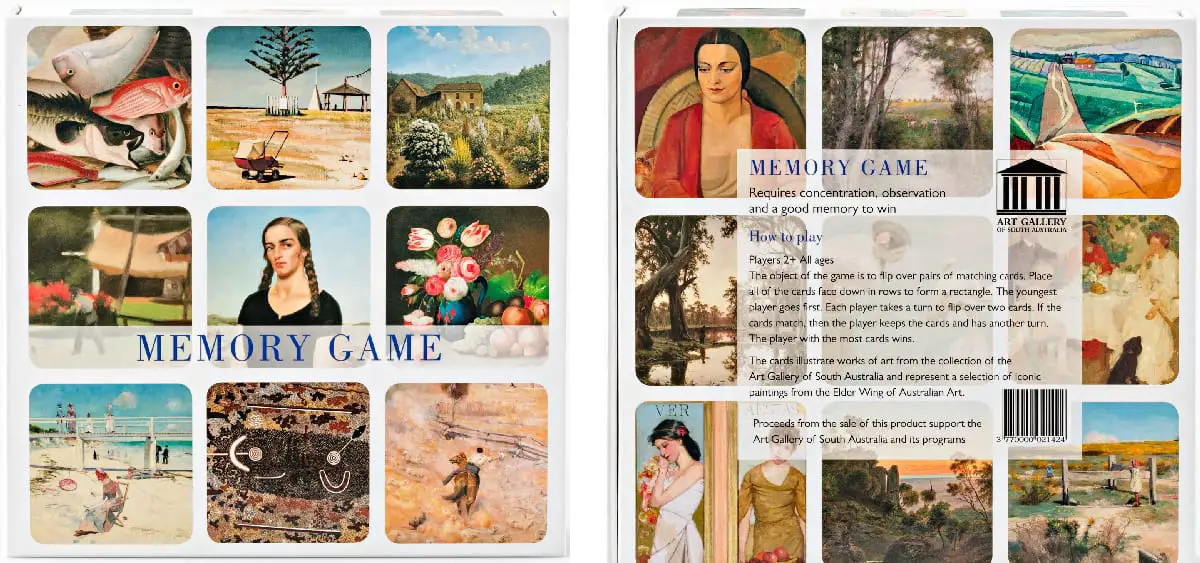
This memory game is proposed by the Australian Gallery of South Australia and features paintings by Australian artists. The cards illustrate works of art in the collection of the Art Gallery of South Australia, including a selection of iconic paintings from the Elder Wing of Australian Art.
is proposed by the Australian Gallery of South Australia and features paintings by Australian artists. The cards illustrate works of art in the collection of the Art Gallery of South Australia, including a selection of iconic paintings from the Elder Wing of Australian Art.
Cards are square-shaped with a width of about 5.5 cm.
3 Memory Games About Specific Art Techniques
Collage Memory Game (BisPublishers)

This memory game by Anja Brunt is great for introducing to contemporary collage (Collage is a technique where the artwork is made from an assemblage of different forms). 30 artists feature a stunning mix of techniques in 60 cards (two artworks per artist).
by Anja Brunt is great for introducing to contemporary collage (Collage is a technique where the artwork is made from an assemblage of different forms). 30 artists feature a stunning mix of techniques in 60 cards (two artworks per artist).
Two cards match when they are from the same artist – which can be recognized by the same style in collage art.
The leaflet (seen before) gives the name of each artist, their country, their website and a small print of their two artworks. This allows to check if the pairing of cards is correct, if any doubts.
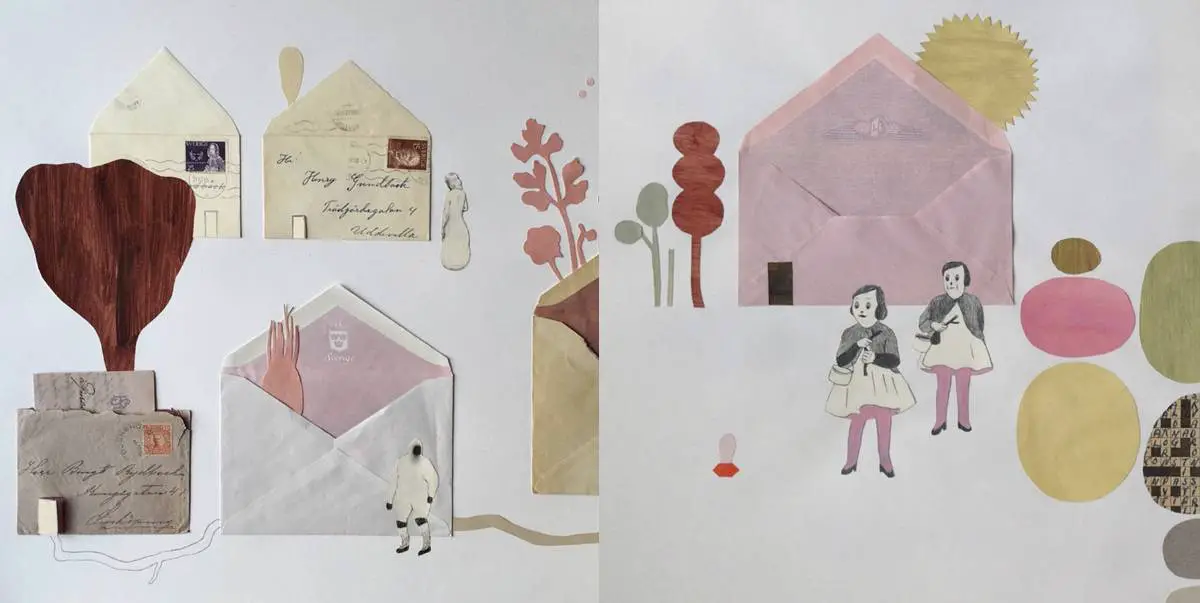
Pairing is sometimes easy like with these two paired cards with the exact same style and a similar theme.

It can be a bit more difficult when the theme of the painting is different but the style similar.

Or the theme is similar but the style is different.
I really highly recommend this game. Collage is great fun for students, as the technique is relatively accessible and they can experiment by themselves. Also, the artworks are often funny and inspiring.
Optical Illusions Game (BisPublishers)
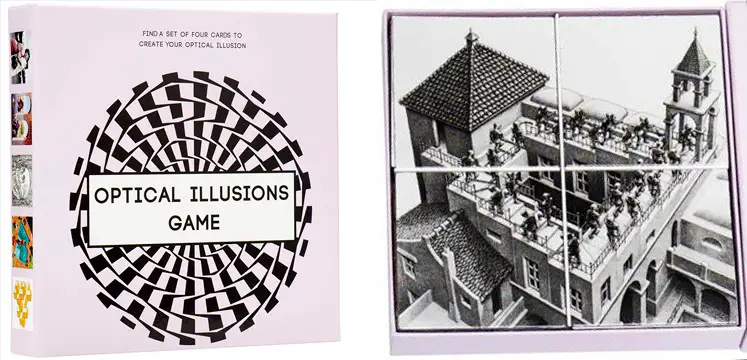
In Optical Illusions , the goal is to collect four cards that form an optical illusion. The player who collects the most optical illusions wins the game. There are 20 sets of 4 cards in the game, making 80 cards in total: this game can be played as a memory game, or like a “Happy families” game (if you change a bit the standard rule).
, the goal is to collect four cards that form an optical illusion. The player who collects the most optical illusions wins the game. There are 20 sets of 4 cards in the game, making 80 cards in total: this game can be played as a memory game, or like a “Happy families” game (if you change a bit the standard rule).
I like this game because when you build your 4 card set, you also at the same time obtain a result that you can share with the other players: a new optical illusion that can be commented and become a starting point from an educational point of view.
Many of these illusions have been created by contemporary designers and artists. A brochure shows the illusions and explains them.
Can You See What I See Memory Game (BisPublishers)

In “can you see what I see ” (by Tineke Meirink), original pictures taken generally outdoors are modified by adding small sketches to them. The rule is to match the original picture and the modified one.
” (by Tineke Meirink), original pictures taken generally outdoors are modified by adding small sketches to them. The rule is to match the original picture and the modified one.
What I love in this concept, and the game itself is that:
- The photo edits are really funny. Our surroundings take a new life of their own.
- Similar to the “Collage Memory Game” also by Bis Publishers, the game teaches us (and the students) a specific technique, while making this process painless. Once you find a match, you cannot help but look closely at how the original picture was modified.
So, of course, I also highly recommend this game!
5 Memory Games About Specific Great Artists
Vincent Van Gogh
Van Gogh Memory Game (Van Gogh Museum)

In collaboration with the Van Gogh Museum, BIS Publishers has produced this creative Van Gogh Memory Game . Each set of cards consists of two different images from the museum’s collection, together forming a theme and telling a little story about Vincent Van Gogh’s oeuvre. Often, a painting is paired with its sketch, which is a great way to start to understand the painter’s creative process. Also, it can be paired with a letter written by Van Gogh that speaks about this painting.
. Each set of cards consists of two different images from the museum’s collection, together forming a theme and telling a little story about Vincent Van Gogh’s oeuvre. Often, a painting is paired with its sketch, which is a great way to start to understand the painter’s creative process. Also, it can be paired with a letter written by Van Gogh that speaks about this painting.
This memory game contains 40 cards and an instruction booklet.
The Van Gogh Museum in Amsterdam has a great selection of Van Gogh’s work, but it would have been even better if the Van Gogh Museum had partnered with the museums over the world that have Van Gogh’s most renowned paintings.
But I really recommend this game though as it has a great educational value.
Van Gogh Memory-Game (Fridolin)
This Van Gogh Memory Game game is similar to the Klimt Memory-Games below, but with Vincent Van Gogh’s artworks.
game is similar to the Klimt Memory-Games below, but with Vincent Van Gogh’s artworks.
Other Artists
Klimt Memory-Game (Fridolin)
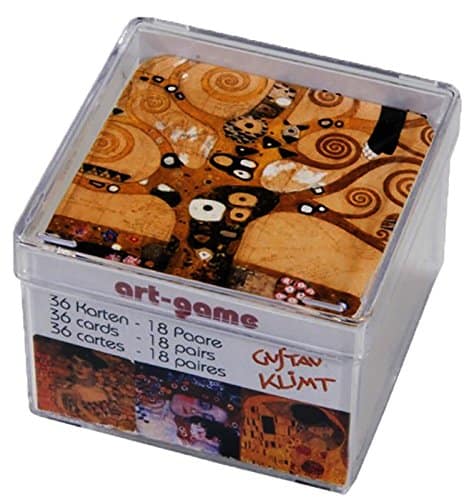
This is a small memory game with Gustav Klimt artwork square cards . 36 5×5 cm (2″x3″) cards (18 pairs) are encased in a Plastic Box.
. 36 5×5 cm (2″x3″) cards (18 pairs) are encased in a Plastic Box.
The cards themselves do not have any additional information, and there is no additional leaflet. So this is really a basic memory (but a cheap one, and the choice of the artworks is good). This is why I do not recommend this game unless you are looking for something very simple.
Eames Memory Game (AMMO)

This Eames Memory Game features 36 designs (72 cards) of Charles and Ray Eames: furniture, graphics, textiles, toys, architecture, exhibits, and films. It is a standard memory game as each artwork is present twice in the game.
features 36 designs (72 cards) of Charles and Ray Eames: furniture, graphics, textiles, toys, architecture, exhibits, and films. It is a standard memory game as each artwork is present twice in the game.
Emil Nolde: Memory Games

Emil Nolde: Memory Games features 32 of German Expressionist painter Emil Nolde’s flower watercolors. It is a standard memory game as each artwork has its exact match.
features 32 of German Expressionist painter Emil Nolde’s flower watercolors. It is a standard memory game as each artwork has its exact match.
The memory game comes with a booklet introducing the artist and the works included in the game.
Printable Art Memory Games And Other Art Games
I hope you liked this art memory games list, but after reading this you might realize that in fact, you are interested in another type of art-related games:
- Printable Art Memory Games: If you want more variety than this list, nothing beats printable memory games, as there are so many of them. I do intend to do a post on printable art games in the near future. I will link to it from this post as soon as it is available. Of course, you will not achieve the professional print quality of offset printed games though, and the cost of full-color printing on personal printers is rather high.
- Art Card Games: They are great for older children (memory games are ideal for kindergarten and preschool children) because they introduce more dynamic and advanced game rule mechanisms, while still being inexpensive games… To know more, read this post where I explain 15 art card games
 .
. - Art Playing Card Games: Even less expensive are standard playing cards with artworks on the face of each card (a different artwork on each card). You can play your usual card games (war, Rummy, etc…), and still introduce children to works of art. And there is often more information about the artists, the year the artwork was made, the title of the artwork. Also, you can go a step further and use rules that leverage this information to use them as true educational games. Read this post to know about 16 Art Playing Card Games
 .
. - Printed Flashcard Art Games: They are a great learning solution, as their size allows to include a lot of information about each artwork. Additionally, the artwork reproductions are bigger than on standard playing cards, so you can see the details much better. Read this post to see which printed art flashcards are available, and get 8 free rules (my gift to you) that will transform your flashcards into great games that students love.
Edudingo.com is a participant in the Amazon Services LLC Associates Program, an affiliate advertising program designed to provide a means for sites to earn advertising fees by advertising and linking to Amazon.com. We also participate in other affiliate programs which compensate us for referring traffic.



I was looking for a matching game for our home school. We have Van Gogh I wanted Monet or Manet or Rembrandt. Do you have any of these
Dear Penny,
I am sorry, but https://edudingo.com does not sell any games.
I just make posts to help people find the best games out there.
On the following post I wrote you will find some impressionist art card games : https://edudingo.com/art-history-playing-cards-games-for-schools-and-families/ including works by Monet, manet and Rembrandt.
Kind regards
François